
Common Features of Nikon
Digital SLR Cameras
Thoughtful Design
We had the opportunity to work with many different Nikon cameras during the writing of this book, and found that common body design and location of features made for a comfortable transition when going from one model to another. The huge advantage here is that if you choose to work with another camera in Nikon’s line-up, many features will be instantly familiar. This is a real boon if and when you decide to move up to a more advanced model camera. You won’t be starting all over again.
Camera Features
Power Switch
The power switch on all of Nikon’s camera bodies is located on the top of the right-hand grip, and encircles the shutter release button.
The options are simply ‘off’ and ‘on.’ Models from the D80 and up will also illuminate the info display screen on top of the camera if you continue to move the switch to the right and hold the power switch. Being placed close to where your finger rests naturally is great for quickly grabbing your camera and simultaneously turning it on, as well as illuminating the top data screen in low lighting without ever taking your hand away from the grip.
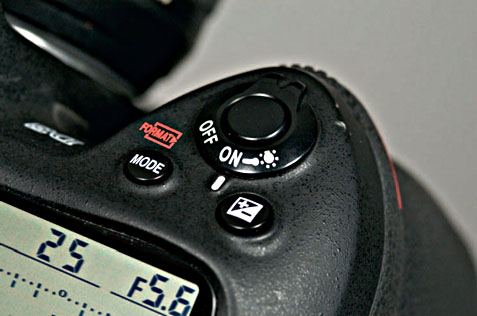

Figure 3.3
Shutter Release Button
The shutter button is conveniently located just above the handgrip, where your right index finger naturally rests.
Depressing the shutter button halfway will set the auto focus and displays your camera settings (and exposure display if in manual mode) both in the viewfinder and on the top control panel. Press all the way down to release the shutter.
Multi-Directional Rear Command Dial
This multi-functional hub controls a host of functions and consists of individual up/down, left/right, and center ‘do it’ buttons.

Figure 3.4
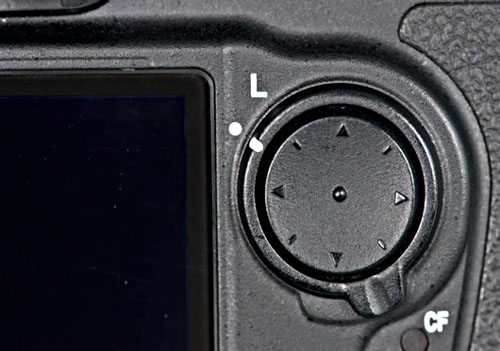
When in menu mode, the directional buttons allow you to navigate through and make changes in the camera menus.
In image playback mode, the horizontal buttons allow scrolling through images and the vertical buttons will change which image data is displayed, such as displaying a histogram metadata, or just the image itself.
The selector is also used to move and designate your focus points.
Main Command Dial
The main command dial is located on the top right side of the back of every Nikon camera. Although some functions vary on some models, it is universally used for changing shutter speed, exposure values, and flash mode.
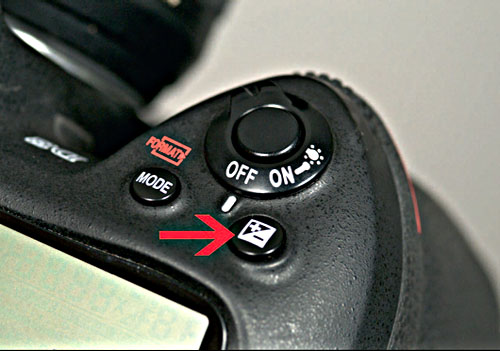
Exposure Compensation
Exposure compensation is controlled in the same way on all Nikons. Press and hold the +/− button located just behind the on/off switch on the top right side of the camera while turning the main command dial to increase or decrease the EV value.
Positive values will result in brighter images, while negative values will make them darker. Remember, exposure compensation is not reset when the camera is turned off, so make sure the EV value is where you want it the next time you shoot!
Reviewing Images
Pressing the playback button will display images on the rear LCD screen on Nikon cameras. It is the top left button on the back of the camera and is marked by a triangle inside a square.
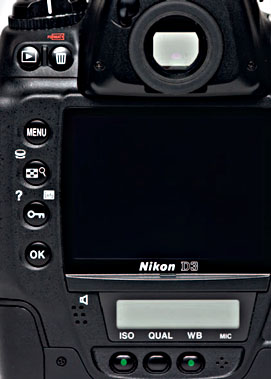
To scroll between single images, use the rear thumb selector’s horizontal directional buttons. You can also view thumbnails for faster navigation by pressing the thumbnail/zoom out button once to view four thumbnails (Figure 3.6), and once again to view nine thumbnails at a time (Figure 3.7) (except D3—hold down the thumbnail/zoom button and move the main dial to the left to zoom out and to the right to zoom in on an image).
If you want to take a closer look, press the zoom in key to magnify an image.
Menus
Every Nikon includes the same main menus including the Playback Menu, Shooting Menu, Custom Setting Menu, Setup Menu, and Retouch Menu.
In the Retouch Menu, cropping, monochrome conversions, skylight and warm filters, and image overlays can be applied in-camera.
All models allow you to create a custom menu by selecting your most commonly used functions from all the menus, aptly named ‘My Menu.’ This saves a great deal of time by limiting the amount of flipping through menus to find what you need when you’re shooting.
ISO
The ISO value controls the sensitivity of the digital sensor: the higher the numerical value, the more sensitivity to light. Higher ISO settings allow for faster shutter speeds in lower light. The inevitable trade-off is more digital noise and less accurate color balance. All models allow you to create a custom menu by selecting your most commonly used functions from all the menus, aptly named ‘My Menu.’ This saves a great deal of time by limiting the amount of flipping through menus to find what you need when you’re shooting.
You can select ISO 200–1600 in all models, with some models such as the D3 adjusting down to ISO 100 and up to ISO 6400.
White Balance
In all Nikon cameras, there are pre-set white balance settings for incandescent, fluorescent, direct sunlight, flash, cloudy, and shade. Auto white balance is another option, which will adjust the white balance using color temperature measured by the image sensor. The ability to preset a custom white balance is also offered in all models.
Quality
You can choose to shoot in NEF(RAW) format, or JPEG small, medium and large. You can also shoot a combination of RAW and any one of the JPEG formats. We like to shoot RAW plus small JPEG. This gives you the best of both worlds: you have the large high-resolution version for editing and a small version, which will quickly load, in your browser for fast proofing.
Protect Images
When viewing your images in playback mode, you can press the protect key to prevent accidental erasure of any important images. Many scoff at this feature but it can really save you if you are shooting a job for pay. It is easier than you might think to mix up images or memory cards and erase important files. Think of it as free insurance.

Figure 3.8
Erase Images
When you come across an image you have no desire to keep, press the delete key (marked by theTrashcan icon). You will then be asked to confirm your intentions by pressing the delete key one more time to erase, or to hit the playback key to cancel.
Focus Modes
S = Single-Servo Auto Focus
C = Continuous Servo Auto Focus
M = Manual Focus
AF Area Mode
Closest Subject
Dynamic Area
Single Area
Metering
Matrix/center/spot
Noise Reduction
On/Off
Image Optimization
Normal
Softer
Vivid
More vivid
Portrait
B&W
Custom (choose sharpening, tone compression, color mode, saturation, hue adjustment)

Nancy Rotenberg
Nancy Rotenberg is a freelance photographer, a writer, and an educator. Her images and editorial have appeared in magazines such as Adirondack Life, Birds & Blooms, Canadian Camera, Country Gardens, National Geographic, Nature’s Best, Peterson’s Photographic and Outdoor Photographer. Nancy’s work has also been used by Hallmark, Red Oak, Reiman Publications, Renaissance and Sunrise Greeting Cards; as well as in calendars such as Inner Reflections, Nikon, Mitsubishi, Smith-Southwestern, Teldon and Willow Creek.
Nancy is the author of three books: How To Photograph Close-ups In Nature, Capturing Nature’s Intimate Landscapes and her latest book, Photography and The Creative Life.
Nancy has been leading photography workshops and teaching for 12 years. Her goal as instructor is to encourage other photographers to create visual statements that go beyond documentation—to photograph intimately and with feeling. Nancy brings creative vision and enthusiasm for the natural world to her workshops and writings, and a passion for experiencing life with joy, heart and soul.
‘Photography is a celebration for me. It is a celebration of what is beautiful in nature and in life. Photography is art for me. It is a verb, a way, and a state of being.
I want to learn techniques and then transcend them. My camera bodies are Nikon’s D3 and Nikon’s D300, and I use Nikon lenses, ranging from the 12–2013;24 mm to the 200–400 mm. My favorite lens is Nikon’s 200 mm macro lens. Although I love good tools, and great optics definitely make a difference, buying the latest and greatest is not a magic wand.
I believe that each one of us has what nobody else has or nobody else can purchase anywhere. We all have our unique light that arrives somewhere from the marrow and emanates from the heart. Creating has to do with your perception of the world and the light and passion that you bring to it. My goal for my own work and my mission for my students is to create images that wouldn’t exist without that light. As we take the gifts of the universe when they are offered to us, we make something particular that wouldn’t have existed without our presence—our consciousness—our light.
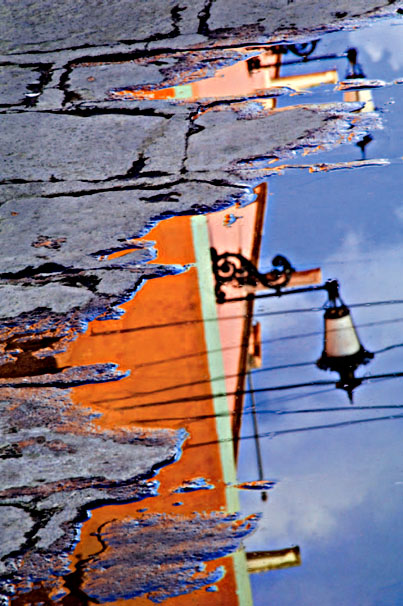
I like to develop a relationship with my subjects—to be aware of every nuance—to go beyond a handshake with them. When you see with mindfulness, when you start to pay attention, you begin to develop an intimacy with your subjects and you no longer walk sightless amongst the miracles and magic that are all around. One of my favorite quotes from R. D. Laing,‘The range of what we think and do is limited by what we fail to notice,’ resonates with me as I travel on my creative journey. It tells me that no matter how much great equipment I have in my backpack, if I don’t pay attention and enter the world with mindfulness, I will miss one of the most important features of seeing and living. I will miss moments and I will miss life.
I work hard at not getting caught up in final product and ego. ‘Failing’ is part of a creative process. If you’re not failing every now and again, you’re not moving—not growing. I remind myself frequently of Eleanor Roosevelt’s famous comment: ‘Nobody can make you feel inferior without your consent.’ If you buy into the premise that photography is about comparing ourselves to others or about perfection, or if you photograph afraid to break any perceived rules, you might miss the opportunity to explore who you are and your own unfolding and your own need to create. When art is viewed only as a noun, and ego is tantamount to creativity, the process will create impoverished photographers, caught up in purpose and constricted awareness. This is why I recently converted my Nikon D200 into an infrared camera. I want to keep on learning and exploring. It is the juice that pumps through my veins and keeps me feeling alive.
Poetry is possible in photography when one employs the creative process. The poems live in your vulnerability and in your own tenderness. I think that it is impossible to create images with depth if you’re not willing to go to that emotional place—even though that place may be filled with tears. Without the poetry, we are only mechanics. Without the feelings, we are emotionally disabled artists.
I once saw a ‘Life Is Good’t-shirt that said’ Sometimes nothing is the right thing to do. ‘The Zen Masters say that you cannot see your reflection in running water—only in still water. Even a hummingbird comes to rest and is still. It is impossible to be on this creative journey without incorporating stillness into the plan. It is impossible to be grounded without coming home to yourself. In that stillness, you remember what you already knew and are able to provide a home for the poetry. ‘And the end of all our exploring,’ said T. S. Eliot, ‘will be to arrive where we started and know the place for the first time.’ Out of the stillness, a mirror reflects you back to yourself.
We have a gift to show others what may be invisible to them. I enjoy all aspects of photography, but I think that this ability to show others details they may be missing is why I particularly enjoy macro photography. When a viewer sees a small dew drop on a petal, a butterfly close-up, the beauty and grace of leaf, or a small reflection in a river, I feel blessed to be able to share that beauty with the universe. For me, macro photography is a way to express intimacy and to appreciate the small moments that are often overlooked and underappreciated.

Figure 3.11
Photography can be more than a great image. Photography can be about bringing your light from the deepest center of your being. Photography can be about saying grace for the moment, for each other, for our attention—our affection—our affect.
Ansel Adams said that ‘We don’t make images with just a camera. We make images with the books we have read, the music we have heard, the people we have loved.’ Surround yourself with all that is beautiful and make the ordinary the sacred. The creative moment is when all who you are and what you have experienced ‘arrives’ — and then you send it out to the universe. In that offering, there is a transformative energy that heals, that creates, that makes the world a better place.’

